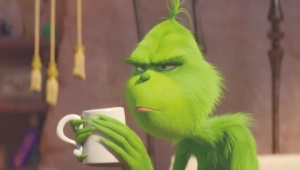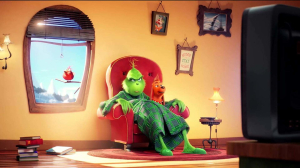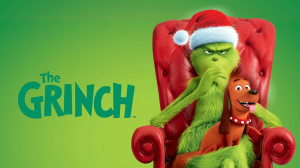
When it comes to Christmas stories that have captured imaginations through the years, "The Grinch" stands alongside the most cherished. This whimsical tale, inspired by Dr. Seuss’s book and given new life through animations and movies, is more than just a holiday cartoon. It’s a reflection on personal growth and an invitation to reconsider what the festive spirit truly means. In a world bustling with commercial holidays, this animated gem invites viewers to pause and reflect on simpler joys. The Grinch has been part of our holiday culture since its inception in 1958, and its latest animated rendition manages to bring a classic tale to contemporary audiences while maintaining its core message. This rendition is crafted by the creative minds behind “Despicable Me,” featuring the uniquely charismatic Benedict Cumberbatch as the voice of the Grinch. It strikes a delightful balance between honoring the original narrative and introducing elements that resonate with present-day viewers. History and Evolution The tale of the Grinch has evolved substantially since Dr. Seuss first penned it. Initially, it was a beloved children's book that quickly made the leap to screen in an animated television special by Chuck Jones in 1966. Narrated by Boris Karloff, this version became a holiday staple. Later, Jim Carrey took on the Grinch persona in a live-action interpretation in 2000, which, while endearing to some, diverged overtly with its slapstick comedy. In contrast, the latest animated film is a polished convergence of modern animation techniques and timeless storytelling. It's aesthetically Seussian, with the familiar curves and designs that remind viewers why Dr. Seuss's illustrations have remained so iconic over decades. The transition from a tiny book to a full-length feature requires thoughtful adjustments to the story's arc and character depth, and this version manages to expand the narrative without losing its original charm. Visual Delight The visual craftsmanship of this animated feature is thoroughly enchanting. Whoville is depicted as a meticulously crafted environment, teeming with Seussian architecture that feels both magical and tangible. One of the memorable aspects is the quintessentially steep, winding paths and brightly colored facades that evoke the whimsy of a Christmas village coming to life. The contrast between the vibrant, welcoming atmosphere of Whoville and the austere solitude of the Grinch’s mountain lair is sharply drawn. His home is suitably sparse and somber, giving depth to his character, emphasizing how his environment mirrors his internal isolation. This dichotomy between the Grinch’s cold abode and the warmth of Whoville amplifies the narrative theme of longing for connection and belonging. Character Depth The approach to character development, particularly of the Grinch himself, presents a nuanced portrayal. Benedict Cumberbatch brings a distinctive flair to the role, adding layers of emotional complexity through his voice acting. His distinctive voice guides us through the Grinch’s cynical exterior, hinting at vulnerability beneath his hardened facade. Introducing a backstory for the Grinch, which includes a poignant look back to his childhood in an orphanage, adds a layer of empathy the story previously touched upon only lightly. This insight doesn’t dictate the narrative but rather supplements the audience's understanding of the Grinch’s motives, making his eventual transformation all the more impactful. Clever Plot Twists While the core plot remains familiar—centered around a green curmudgeon plotting to snatch Christmas from the unsuspecting Whovians—the narrative spices up with clever new twists. These adaptations are neither intrusive nor overdone; they serve to enhance the intrigue and comedy of the film. Cindy Lou Who, who traditionally serves as a sleepy observer, is given more agency with her own subplot, driving her motivations into the narrative forefront. Her determination to meet Santa for a special wish for her mother adds an emotional touchstone that parallels the Grinch’s own journey and provides a fresh angle to the story. Heartfelt Message The gentle moral at the heart of “The Grinch” is beautifully communicated without overt exposition. Through its vibrant characters and engaging storyline, the film reminds us that the essence of Christmas lies not in material belongings but in joy, love, and community. The climax of the movie gracefully carries this message home, as the Grinch's heart metaphorically expands in response to the unwavering kindness of the Whoville residents. This transformation from isolation to inclusion is not only heartwarming but also compelling, offering viewers a moment of genuine reflection on what truly matters during the holiday season. Musical Accompaniment Music plays an integral role in this animated version, enhancing emotional beats and adding a festive allure. The score by Danny Elfman is both whimsical and immersive, capturing the whimsical spirit of the Whovian world. It complements the storyline and brings added life to the animated sequences. Particularly noteworthy is the incorporation of holiday classics such as “God Rest Ye Merry Gentlemen” and an imaginative take on “You’re a Mean One, Mr. Grinch” by Tyler the Creator. These musical numbers are woven into the narrative, not simply as backdrops but as crucial elements that add depth and playfulness to the film. Humor and Delight Humor in "The Grinch" is elegantly balanced, merging slapstick moments and subtle wit, making it accessible to a varied audience. The comedic timing predominantly rests on the interactions between the Grinch and his faithful dog, Max, whose expressions and actions evoke genuine laughter. Adding to the humor are delightful subplots, such as that involving Fred, the unlikely reindeer, whose presence and antics lend a fresh comedic angle. This humor provides a lighthearted counterpoint to the story’s deeper themes and keeps the rhythm lively and engaging. Side Characters The animated feature's side characters, particularly Kenan Thompson’s relentlessly cheerful Whovian neighbor, provide more than just comic relief. This character’s insistence on befriending the Grinch offers insight into the unwavering cheer embodied by the Whoville community, further emphasizing the movie's central theme of embracing goodness and joy. These vibrant supporting characters help paint a lively picture of the world Dr. Seuss created, contributing to the film’s rich tapestry of life even in fleeting moments. Their interactions with the Grinch not only facilitate humor but also underscore the transformative power of kindness and acceptance. The Art of Animation The artistry in the animation of "The Grinch" impresses with both its vibrancy and its delicate attention to details. Illumination Studios, known for its work in “Despicable Me,” remains true to the distinctive Seussian style while infusing the film with contemporary flair. The fluidity of character movements and intricacy in design make each frame a visual feast. This vibrant storytelling medium enhances the whimsical narrative, bringing visual depth and added dimension to the already lively plot. Family-Friendly Appeal This animated rendition of "The Grinch" is crafted with family audiences in mind, delivering themes universally relatable across age groups. It effortlessly bridges generational gaps, inviting an opportunity for multi-age viewing with thoughtful simplicity encased in complex moral underpinnings. Viewing "The Grinch" as a family can inspire discussions around the importance of empathy, kindness, and community. These underlying morals foster valuable dialogues, adding to the significance of this cinematic experience for children and adults alike. Revisiting a Classic Bringing "The Grinch" into a modern-day setting comes with its challenges, yet this film makes adaptations that feel both organic and timely. By refreshing certain elements while holding firm to the story’s foundations, it ensures the timelessness of the Grinch's journey continues to resonate. Nostalgic viewers will find familiar comfort in its thematic core and artistic style, while new viewers will appreciate its contemporary sensibilities, establishing it as a mainstay in holiday viewership for years to come. Conclusion This latest animated version of "The Grinch" achieves a delicate balance between tradition and innovation. It salutes Dr. Seuss's original narrative and imbues it with a fresh perspective, ensuring it remains relevant to today’s audiences without losing its original spirit. The vibrant animation, engaging character arcs, delightful humor, and poignant message create a holiday film that is more than just entertainment—it's a reflection on the heart's capacity for change. Ultimately, the animated "The Grinch" succeeds not only in capturing the magic and moral of the beloved story but also in fostering a renewed appreciation for the values of kindness, community, and the true spirit of Christmas. It stands as a radiant reminder that our differences, when embraced with love, can lead to the most heartfelt of transformations.


